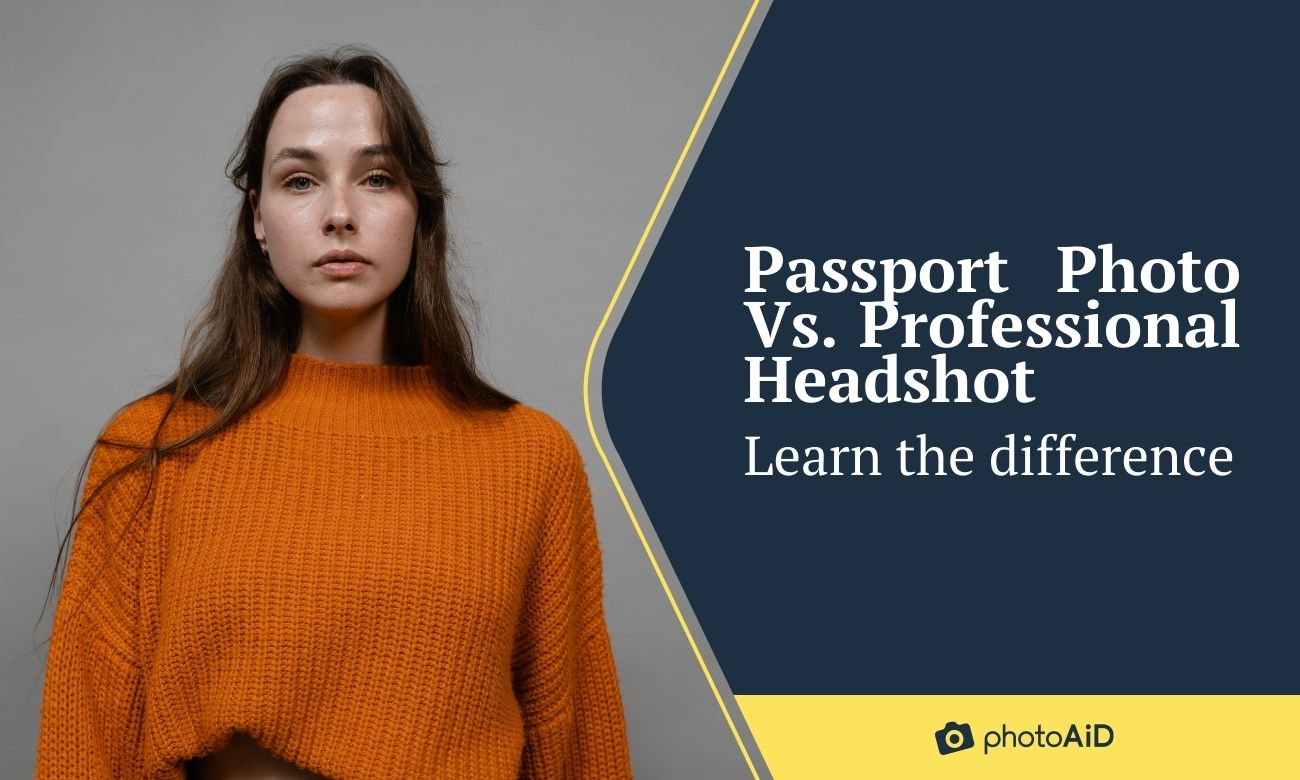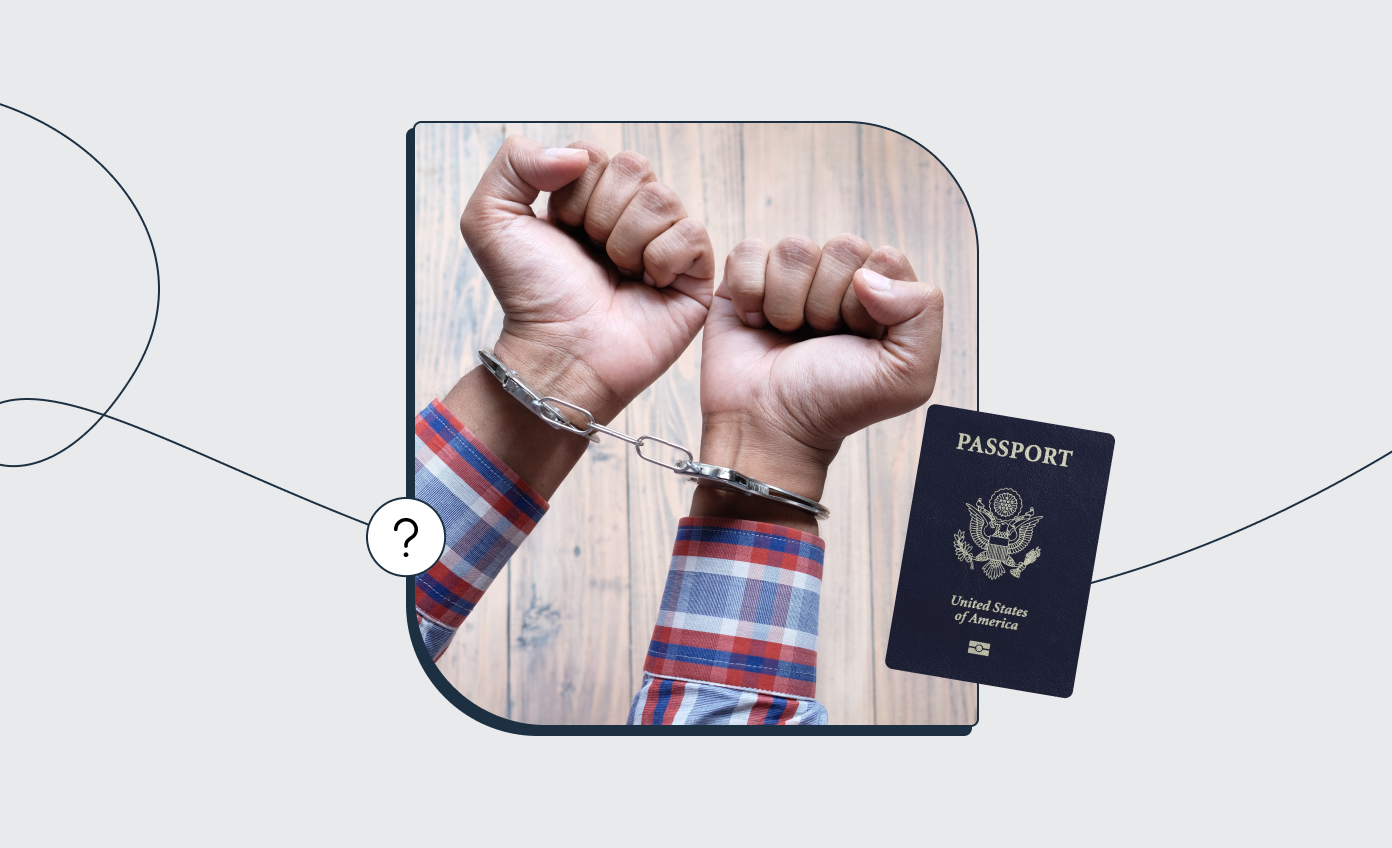Passport photos and professional headshots can seem identical at first glance. Both are likely to have a white background, and essentially display the same subject matter: a person’s head and shoulders.
Such similarity can make you wonder what’s the difference between the two types of photos.
You may even find yourself with a set of professionally-taken headshots that adorn your various social media profiles and wonder, : “Can I use these pictures for my passport photo?”
Find out if the two can indeed be used interchangeably, and what makes passport style photographs different from professional headshots.
Get a compliant passport photo in 3 minutes with PhotoAiD’s passport photo maker.
- Upload or take a photo.
- Let the PhotoAid Al check and fix it.
- A compliance expert will verify the result.
- Download or order a print. Done!


Get a digital passport photo or order prints with help from PhotoAiD®
100% acceptance, expert verified
2x money-back guarantee
3 minutes and done
11,000,000+ happy users
I was pressed for time and couldn’t get hold of a photographer. I found PhotoAiD, took a selfie, uploaded it, and had a compliant passport photo almost instantly. Getting a photo for my baby girl was a breeze, too!
Can We Call a Passport-Style Photo a Headshot?
Technically speaking, headshots refer to a broad category of pictures presenting a person’s head.
In this case, a passport-style photograph meets the definition of a headshot—just like a square meets the definition of a rectangle—and could be referred to as a headshot.
However, the idea of a professional headshot that most people have in mind, may somewhat differ from the definition of a passport photo.
You see, passport pictures are strictly defined types of governmental photographs that need to meet a set of thoroughly prepared regulations, such as size, format, and purpose. These regulations are defined and listed by each country, which makes passport photos slightly different around the world.
What is considered a properly-taken passport picture in the U.S. will be a simple photo in Canada, as these two nations have different definitions of passport-style photographs.
Professional headshots, however, are not bound by any official regulations. There is no institution that sets forth mandatory characteristics of such pictures. Headshots are mostly taken for private and business purposes (e.g., a picture for your business card, website, or social media profile).
The takeaway here is that ‘headshot’ is an open term, whereas ‘passport photo’ is a strictly defined one.
Passport style photo vs. professional headshot—an example
Although we try our best to describe things as accurately as possible, sometimes it is best to visualize things.
With the example below, you may be able to spot the key differences between a passport-style photo and a professional headshot.
Indeed, both photographs present a person’s bust, but the way they do it is fundamentally different.
So—
What’s a passport-style photo?
A passport-style photo must meet strict passport picture requirements. It must be a full frontal shot with a plain white or off-white background. Additionally, the photo must be 2×2 inches in size, with a subject’s face between 1 and 1⅜ inches from the bottom of the chin to the top of the head.
Here are some other official guidelines passport-style photos must follow:
- The subject must maintain a neutral facial expression (a closed-mouth smile is acceptable).
- Prescription glasses, headgear, and accessories aren’t allowed.
- All digital alterations are prohibited.
- Attire must contrast with the background; clothes should be dark colored and without patterns.
You can study these visual passport photo examples to better understand the requirements.
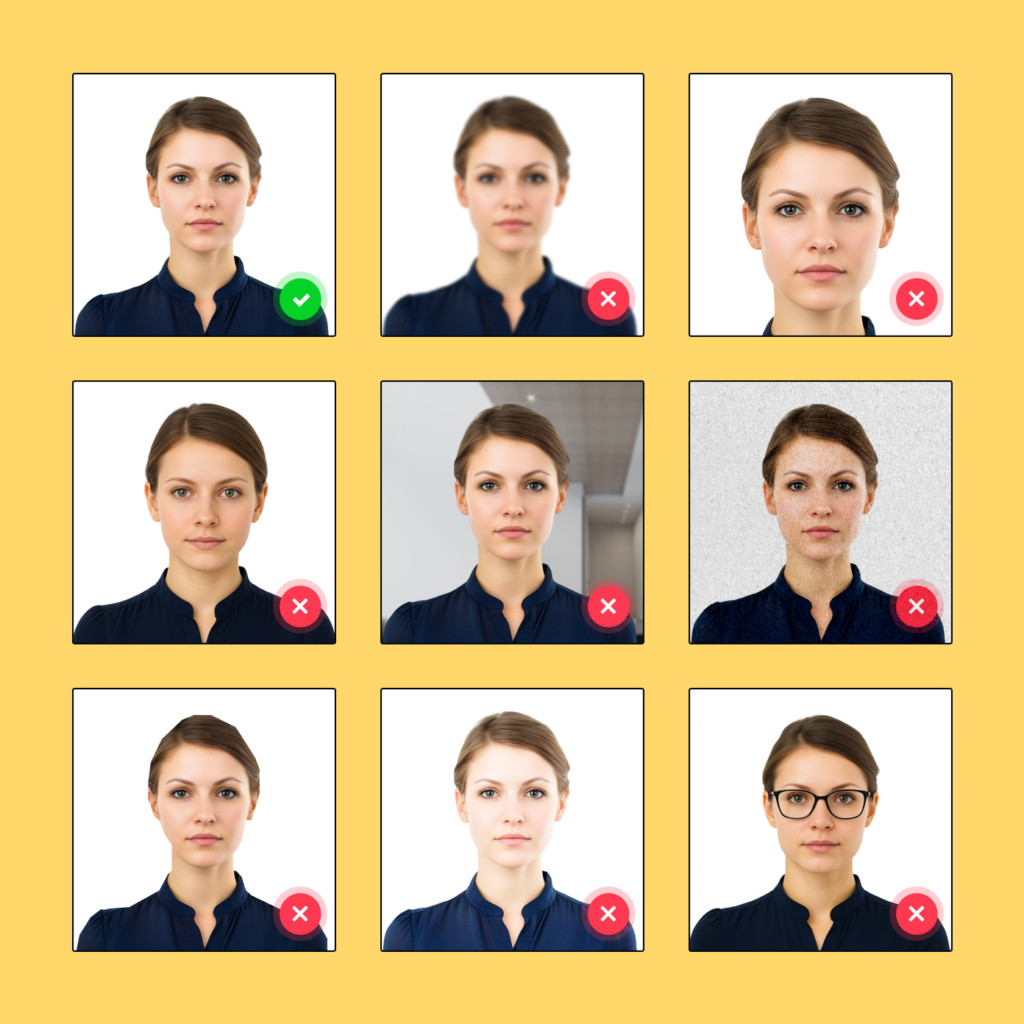
Headshots are a lot more flexible. Depending on the purpose of the photo and your equipment, the photograph may have a more extravagant background. Additionally, headshots do not have any restrictions on the subject, so individuals are free to pose however they like (with or without accessories).
Although headshots are not strictly defined, there is a set of good practices on how to get a good-looking snap. We cover that in more depth below.
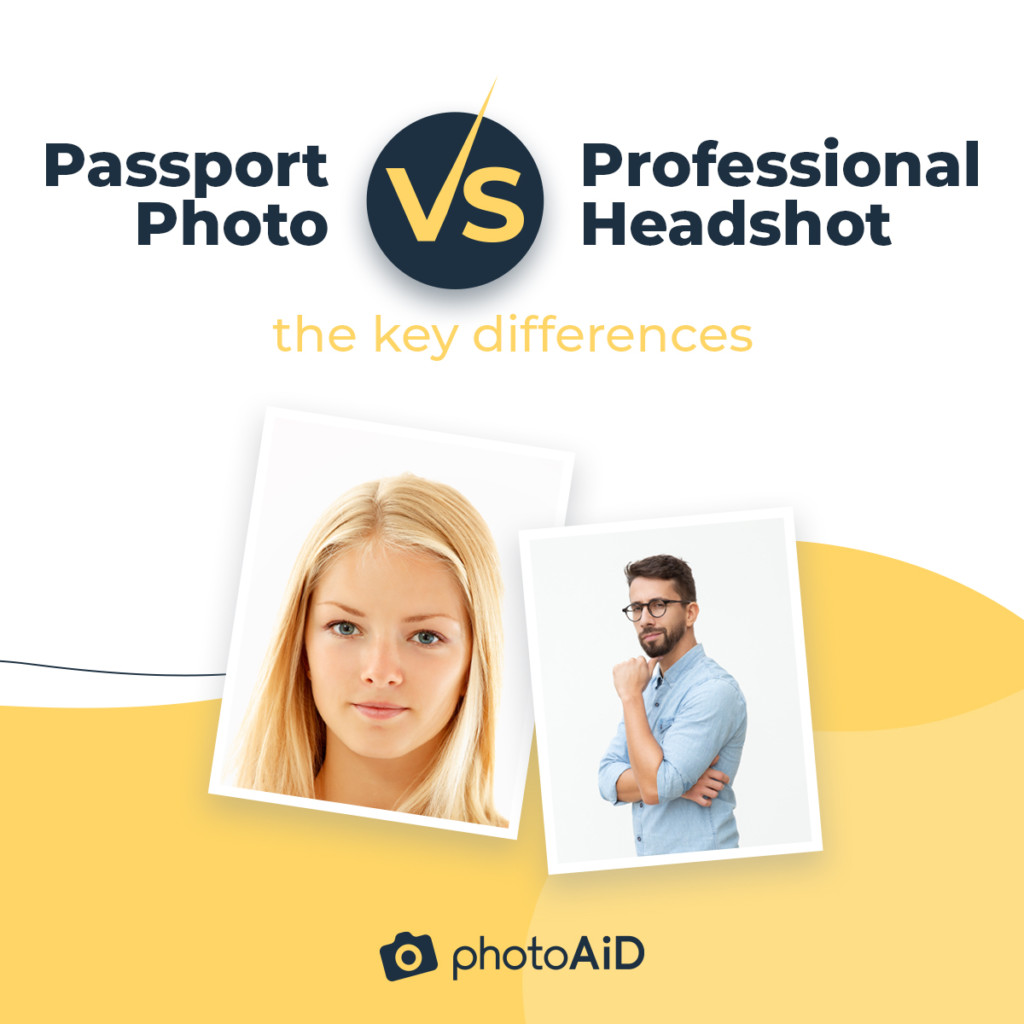
Headshot Picture vs Passport-Style Photo: Key Differences
To fully comprehend how different passport photos and headshots are, we invite you to follow our in-depth comparison.
The following paragraphs may also be beneficial for you to understand what makes a proper passport photo and what makes a good headshot.
The purpose
First and foremost, it is the purpose that makes the main difference.
Passport photographs are used for official, government-issued documents, such as passports, visas, green cards, etc.
Headshots are taken for private and corporate purposes, and the most prominent example here would be actor’s headshots, but it could also be a profile photo for your social media platform or for your business card.
Pose
Posing is crucial. It is what makes the difference between an accepted and rejected passport photo.
For passport photos, there is a standardized set of conditions (with individual exceptions) regarding your pose. For the majority of nations, including the United States, you need to stand directly facing the camera, remain in an upwards position and have a neutral facial expression (only the United States allows a closed-mouth smile). Headshots, on the other hand, allow for some levels of freedom of expression.
You may pose in a head-on position, but you are equally allowed to present your profile. If you feel comfortable, you may proudly display your smile and have your arms crossed–the only thing you need to bear in mind are the aesthetics.
The background
Passport photographs require a plain white background. No objects, shadows, or people can be visible behind you. Small deviations in terms of the background color are allowed, but it has to stay within white-grayish tones.
Headshots often come with a plain background as well, but these can have any color you desire. Companies often decide to use their organizational palette. What background you decide upon in your headshot is up to your personal liking.
According to professionals working in the niche, however, a non-distracting background is recommended—it could be layers of brick behind you, or a blurred interior of your office.
Size, format, and resolution
As you may have already figured out, passport photos are additionally regulated in their technical specifications.
Based on the U.S. example, passport photos need to have a 1 x 1 (square) format (this is also referred to as, “aspect ratio”). On the other hand, European countries follow a rectangular (close to 3 x 4) format.
For consistency, let’s stick with the United States.
U.S. passport photos must measure exactly 2 inches by 2 inches after printing. Moreover, the accepted resolution for digital photographs must be a minimum of 600 by 600 pixels, up to a maximum of 1200 x 1200 px.
Passport photos printed with different dimensions will result in a rejected application.
The size of a professional headshot photograph however, does not have strict size limits and can be printed on poster paper, standard 8” x 10,” or on business cards (or anything in between)–based on customer preferences. The recommended resolution for your headshot is anything starting from 600 px. Values below that number may result in poor-quality images.
Related reading:
Post-processing and alterations
According to the U.S. Department of State, passport photographs cannot be modified in any way. Thus, to ensure your passport application gets accepted, refrain from performing any post-processing to your passport pictures—that means no filters, no enhancing the light, nor any removal of imperfections.
The only modification that is allowed to be done to passport photosis simple cropping (to the required size).
Head shot photographs on the other hand, are usually enhanced after shooting since professional photographers take care of post-processing to make the final pictures as appealing as possible—that can include filters, removal of blemishes, skin tone changes, etc.
Photography equipment
You may have noticed a certain pattern here: Passport photographs have strict guidelines, whereas headshots do not. However, things get a bit more relaxed when it comes to the equipment for taking photographs.
Both passport photos and headshots can be taken using any suitable device—and by suitable, I mean capable of meeting the minimum technical requirements.
Thus, smartphones, digital cameras, or professional DSLR cameras operated by photographers, can all be used for either type of image.
Despite selfies not being recommended for either type of photo, our highly-rated service provides a caveat to this notion—keep reading to find out how to take a U.S. passport photo with your smartphone.
Perfect Passport Photos in Seconds with PhotoAiD®
Passport photographs are bound by numerous regulations, and there is no way around that. The good news, however, is that there is a way to take passport photos from your own couch.
PhotoAiD® is a professional passport photo tool that transforms your smartphone photographs into passport photos in fewer than 10 (ten) clicks.
The app removes the background of your photo and replaces it with a plain white one. Within 3 (three) seconds the software adjusts the cropping to fit passport standards, and simultaneously checks your photograph’s compliance with official requirements.
PhotoAiD® requires no prior experience in taking ID photos, as it has been designed to create perfect passport photos automatically. The program’s easy and intuitive interface, with exposed buttons and no distractions, ensures a smooth walk through the process of converting your ordinary images into passport photos.
See the selection of available documents and take your ID photograph with PhotoAiD®.
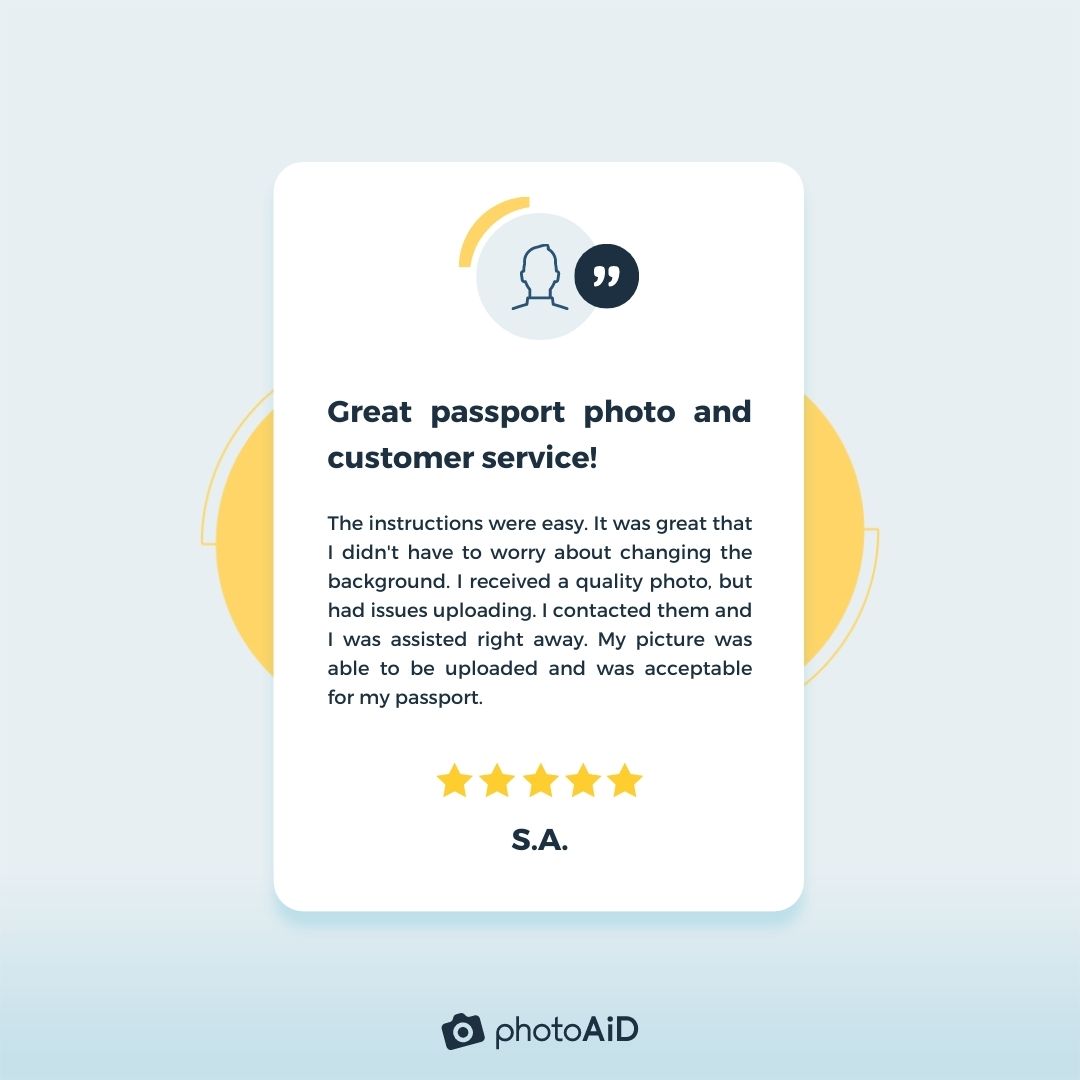
FAQs
Still a little blurry about the difference between headshots and passport photos? Read through the following questions and answers for additional information.
Can I use a passport photo for a professional headshot?
What is a passport-style headshot?
Is a headshot photo the same as a passport photo?
What is a professional headshot photo?
What is a passport-style photo?
Summary
In our opinion, the easiest way to distinguish a passport photograph from a headshot picture is by examining the background and posing.
Due to its low aesthetic attributes, plain white backgrounds are not the most common choice for headshots, and are mainly associated with passport-style photographs. Similarly, a neutral facial expression is not considered to be the most charismatic one, which makes it a better fit for passport photos, rather than headshots.
With PhotoAiD® however, it’s possible to get passport photos that rival professional headshots since you can snap away until you’re satisfied with the final shot!
